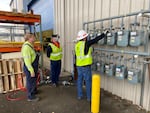
FILE - In this undated photo, NW Natural employees test blended hydrogen gas at the company's facility in Sherwood, Ore.
Courtesy of NW Natural
Oregon’s largest natural gas utility is once again drawing criticism from environmentalists and its customers over attempts to lower emissions by blending what it says is a low-emission fuel into its natural gas supply.
NW Natural launched in June a three-year pilot project that involves blending hydrogen and natural gas at its southeast Portland facility and sending it to customers. The move has prompted a group of Oregon environmentalists, Portland architects, building contractors, physicians and customers to call on state leaders to stop the project.
Natural gas is almost entirely methane, a potent and planet-warming greenhouse gas that is responsible each year for 40% of Oregon’s greenhouse gas emissions and an estimated one-third of global climate change. Hydrogen, however, can be a zero-emissions fuel depending on how it’s produced. If blended with natural gas, it could lower greenhouse gas emissions from burning natural gas alone, NW Natural said.
But critics say this blending could be dangerous to public health — burning both hydrogen and natural gas in homes has been shown to increase risks for respiratory illnesses. They say NW Natural has not alerted customers, and is delaying its transition away from fossil fuels needed to meet state emission reduction targets.
Environmentalists say the company appears to be reviving its failure in Eugene in 2022, when it scrapped a plan to blend hydrogen into the gas supply after public outcry over its lack of transparency and community engagement.
Related: NW Natural once again misses its own targets to offset emissions with renewable natural gas
Customers concerned
Anna Reid lives in Portland’s Brooklyn neighborhood near the NW Natural facility where the blended hydrogen and natural gas is made, and is likely getting the gas in her home. She only found out about it because her neighbor put up a homemade yard sign opposing the project.
“What makes me uncomfortable is the lack of transparency,” Reid said. “Tell us what you’re doing and why you came to this decision, and what sort of data you have around it. Obviously people would have concerns, so how can you put our minds at ease?”
She’s among those concerned that the project is moving forward without local or state oversight.
On Friday, representatives from 46 Oregon-based nonprofits and companies signed a letter to Gov. Tina Kotek, Portland-area legislators, members of the Multnomah County Board of Commissioners, the Portland City Council and the Public Utilities Commission that asked them to intervene.
“Simply put, blending hydrogen into gas for home heating and cooking is not a climate solution,” they wrote.
Related: NW Natural linked to another Oregon lawmaker trip to tour Danish biogas facilities
The signatories include Oregon Physicians for Social Responsibility in Portland, Portland- and Seattle-based Climate Solutions, Northwest Energy Coalition, Portland-based Birdsmouth Design-Build, Green Hammer Design-Build, Salazar Architect Inc, Harka Architecture and Opsis Architecture.
“NW Natural appears to be acting without any oversight, accountability, or transparency around the amount of hydrogen being blended or the health and safety impacts that blending could have on customers,” they wrote. “These actions seem to fall between the cracks of Oregon’s existing regulatory system, and action by state leaders is necessary to ensure that appropriate health and safety checks are in place before this blending continues.”
Regulators have not looked into the project.
Spokespeople for the Oregon Department of Energy and the Oregon Public Utilities Commission said it didn’t meet their threshold for review because it isn’t linked to rate hikes or is impeded by jurisdictional rules.
David Roy, a spokesperson for NW Natural, did not answer Capital Chronicle questions about the number of customers who are receiving the hydrogen blended gas, where they live or whether the company conducted any community or customer outreach about the project. NW Natural has about 2 million residential and commercial customers in Oregon and southwest Washington.
“The small amount of hydrogen blending (less than 0.2% by volume) from the pilot is within the pipeline quality standard requirements,” he said via email.
Roy said other U.S. and European utilities are also experimenting with hydrogen blended into natural gas, at ratios of up to 20% hydrogen.
Related: Eugene seeks new decarbonization strategies after failure of natural gas ban
Replacing even 20% of natural gas with hydrogen only reduces emissions from natural gas by up to 7%, according to the International Renewable Energy Agency.
“NW Natural is committed to effectively addressing climate change and moving urgently towards decarbonization of the energy sector,” Roy said.
Rather than hydrogen, the critics said in their letter that Oregonians need heating and cooling pumps powered by renewable electricity, not natural gas furnaces and stoves. Climate scientists have said that countries worldwide need to reach net-zero emissions of greenhouse gases by 2050 to avoid the worst impacts of climate change by the end of the century. This means natural gas would not have a place in the energy sector of the future.
“Building new hydrogen infrastructure for home heating is likely to create stranded assets and delay the transition to heat pumps,” the letter said, “which provide not only more efficient and affordable heating, but also life-saving cooling as Oregon communities face increasingly frequent and deadly heat waves.”
The costs of producing hydrogen are far greater than that of electrifying homes and powering them with emissions-free solar and wind energy, experts say. Each ton of emissions cut from blending hydrogen with natural gas costs three times as much as the next most expensive method, which is to draw carbon from the atmosphere using large machines, according to the International Renewable Energy Agency.
Oregon Capital Chronicle is part of States Newsroom, a network of news bureaus supported by grants and a coalition of donors as a 501(c)(3) public charity. Oregon Capital Chronicle maintains editorial independence. Contact Editor Lynne Terry for questions: info@oregoncapitalchronicle.com. Follow Oregon Capital Chronicle on Facebook and X.